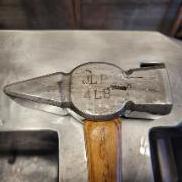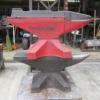
humphreymachine
Members-
Posts
153 -
Joined
-
Last visited
Contact Methods
-
Website URL
http://www.facebook.com/BENJAMIN.CAMPBELL.ANTIQUES?sk=wall
Profile Information
-
Gender
Male
-
Location
Eastern Massachusetts
-
Interests
I’ve long had an interest in railroad history, antique wood and metal working machinery, waterpower mills, and the aesthetic beauty of the early industrial landscape in general. I’m an antique dealer by trade and come across many interesting objects in my travels. While smithing comes in handy for some work related projects it is primarily a hobby. I use my shop for various ‘millwrighting’ and antique machinery repair type projects but hope to pursue modern sculpture as well. I prefer using antique tools to making my own. I guess it’s the collector in me and my appreciation for objects from an other era and the history they represent.
Recent Profile Visitors
-
Two recent acquisitions. 188 LB Mouse Hole and? Not sure who made the top example but thinking it may be another M&H?
-
Weight of Fisher sawers anvil
humphreymachine replied to humphreymachine's topic in Anvils, Swage Blocks, and Mandrels
Great information. They don't appear to have incorporated the integral handles in the larger sawer's anvils(although I could see an advantage in having two handles(one at each end) on the larger ones). Any idea what the cutoff weight for integral handles was? -
Weight of Fisher sawers anvil
humphreymachine replied to humphreymachine's topic in Anvils, Swage Blocks, and Mandrels
I think you are correct Foundryman. On closer examination the body of the one on the right appears to be wood and probably the example on the left as well. -
Weight of Fisher sawers anvil
humphreymachine replied to humphreymachine's topic in Anvils, Swage Blocks, and Mandrels
Impressive collection. What is the story with the example in the upper left and the one to its right? There appears to be a dovetail connection between a cast block and steel plate? What was the largest weight sawer's anvil commonly stocked by Fisher? -
Weight of Fisher sawers anvil
humphreymachine replied to humphreymachine's topic in Anvils, Swage Blocks, and Mandrels
-
Weight of Fisher sawers anvil
humphreymachine replied to humphreymachine's topic in Anvils, Swage Blocks, and Mandrels
Thank you njanvilman - an educated approximation was just what I was looking for. Were these never cast with the weight designation on the base? Were they sold by weight or face size? I would have assumed that were sold in 250 - 300 - 350 - 400 etc etc or similar pound increments and casting patterns made to suit. Another member suggested that these have harder faces than London style anvils. Can you confirm this? Thank you everyone else for your suggestions. The lack of horn and heal make it rather unwieldy so it may have been a while before I got around to performing the water displacement test. Great idea though -
Weight of Fisher sawers anvil
humphreymachine replied to humphreymachine's topic in Anvils, Swage Blocks, and Mandrels
Thank you everyone for the replies. PaperPatched - thank you for the images. if yours is close to 13" high then our weights should be similar. Njanvilman - I was going to ask whether the black paint might be original. Don't worry - I like to leave my tools in as found 'old surface'. I look forward to hear what you have to say about weights. -
Weight of Fisher sawers anvil
humphreymachine replied to humphreymachine's topic in Anvils, Swage Blocks, and Mandrels
I am guessing/hoping/assuming that someone here will have the answer. I just unloaded it with gravity in my favor. It's not going back in my vehicle any time soon. It does not appear 100 pounds heavier than my 300 hundred pound London style Fisher and it does not appear to have as much mass as 2 200 pound anvils but it can be tough to tell. They are bottom heavy, chunky and hard to move without the natural hand holds on a traditional anvil. -
Bought this 1941 Fisher sawer's anvil today. No numerical weight mark like I am accustomed to but there are four vertical lines or '1's. Is it a 400 pounder? I would have guessed closer to 300 pounds but it can be tough to tell with these chunky non London pattern anvils. 13 inches high. 12.5 x 7 inch top face with canted corners. 16 3/4 x 12.5 inch foot print.
-
Stump anvil or huge hardie?
humphreymachine replied to humphreymachine's topic in Tools, general discussion
It does not feel solved to me. It is still not clear to me what kind of tradesman would have used this and why he would have wanted this pattern to protrude from his work rather than be stamped into it? Could it be a silversmith's tool which has taken on the patina of a blacksmith's tool? I don't envision using this texture in my work which raises the question - sand out the embossing or preserve it as an artifact/collectible tool? I wonder whether this might emboss the pattern in the end of silver and silver plate spoons and ladles? -
Stump anvil or huge hardie?
humphreymachine replied to humphreymachine's topic in Tools, general discussion
There is a new twist to this discussion as revealed in the photograph below. What I thought were several hammer marks in the face which I would need to sand out turned out upon cleaning to be two graduated sets of intentionally formed geometric shapes. Both sets of three loosely resemble battle axes or garden edgers. One set of three is nearly semicircular while the other is more pointed. Presumably these are intended to impart a maker's mark or repetitive patterns which protrudes from a piece of work rather than embossed into it. So what do you think now? -
Stump anvil or huge hardie?
humphreymachine replied to humphreymachine's topic in Tools, general discussion
It would fit nicely in an anvil with a 2 inch hardy hole. Do larger anvils have holes that large? Could be used in a swage block as well. -
Stump anvil or huge hardie?
humphreymachine replied to humphreymachine's topic in Tools, general discussion
Thank you for your input everyone. Jim - this example is forged iron or steel - that is scale on the post. Given the lack of rust I don't think that it is terribly old(or it was stored in a very 'friendly' environment). Frosty - I agree with your "why" query but I do seem to see smaller hardies which are merely a square or rectangular block on a hardie stem. -
I can’t decide whether this is a stump anvil or a hardie for a giant anvil. It may also me a tinsmith’s tool but the post is not tapered enough to fit my stake plates. What do you think?


